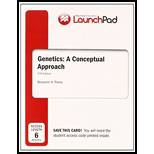
To determine:
The characteristic that would respond best to selection among body weight, tenderness, and fat content in beef cattle.
Introduction:
Response to selection is denoted by the “R”. It determines the extent to which a trait subjected to selection changes in a generation. It is calculated as the product of narrow-sense heritability and selection differential. Mathematically, it can be expressed as follows:
Here, R is the response to selection.
S is the selection differential.
Explanation of Solution
To determine the characteristic that would respond best to selection, narrow-sense heritabilities of each trait should be calculated. The trait having highest narrow-sense heritability would have a highest response to selection as there is a direct relation between narrow-sense heritability and response to selection.
Narrow-sense heritability is denoted by the symbol h2. It represents the proportion of
Here, h2 is the narrow-sense heritability.
VA is the additive genetic variance.
VP is the genetic variance.
There are three components of phenotypic variance, which are used in its calculation. These components are genetic variance, environmental variance, and genetic-environmental variance. Furthermore, genetic variance also has three components; additive genetic variance, dominance genetic variance, and gene interaction variance. Mathematically, it can be expressed as follows:
Narrow-sense heritabilities of among body weight, tenderness, and fat content in beef cattle are as follows:
1. Narrow-sense heritability for body weight.
2. Narrow-sense heritability for tenderness.
3. Narrow-sense heritability for fat content.
The highest narrow-sense heritability is of tenderness, which is 0.43. So, the characteristic that would respond best to selection is tenderness.
Tenderness would respond best to selection among body weight, tenderness, and fat content in beef cattle.
Want to see more full solutions like this?
Chapter 24 Solutions
LaunchPad for Pierce's Genetics: A Conceptual Approach (6 month access)
 Human Anatomy & Physiology (11th Edition)BiologyISBN:9780134580999Author:Elaine N. Marieb, Katja N. HoehnPublisher:PEARSON
Human Anatomy & Physiology (11th Edition)BiologyISBN:9780134580999Author:Elaine N. Marieb, Katja N. HoehnPublisher:PEARSON Biology 2eBiologyISBN:9781947172517Author:Matthew Douglas, Jung Choi, Mary Ann ClarkPublisher:OpenStax
Biology 2eBiologyISBN:9781947172517Author:Matthew Douglas, Jung Choi, Mary Ann ClarkPublisher:OpenStax Anatomy & PhysiologyBiologyISBN:9781259398629Author:McKinley, Michael P., O'loughlin, Valerie Dean, Bidle, Theresa StouterPublisher:Mcgraw Hill Education,
Anatomy & PhysiologyBiologyISBN:9781259398629Author:McKinley, Michael P., O'loughlin, Valerie Dean, Bidle, Theresa StouterPublisher:Mcgraw Hill Education, Molecular Biology of the Cell (Sixth Edition)BiologyISBN:9780815344322Author:Bruce Alberts, Alexander D. Johnson, Julian Lewis, David Morgan, Martin Raff, Keith Roberts, Peter WalterPublisher:W. W. Norton & Company
Molecular Biology of the Cell (Sixth Edition)BiologyISBN:9780815344322Author:Bruce Alberts, Alexander D. Johnson, Julian Lewis, David Morgan, Martin Raff, Keith Roberts, Peter WalterPublisher:W. W. Norton & Company Laboratory Manual For Human Anatomy & PhysiologyBiologyISBN:9781260159363Author:Martin, Terry R., Prentice-craver, CynthiaPublisher:McGraw-Hill Publishing Co.
Laboratory Manual For Human Anatomy & PhysiologyBiologyISBN:9781260159363Author:Martin, Terry R., Prentice-craver, CynthiaPublisher:McGraw-Hill Publishing Co. Inquiry Into Life (16th Edition)BiologyISBN:9781260231700Author:Sylvia S. Mader, Michael WindelspechtPublisher:McGraw Hill Education
Inquiry Into Life (16th Edition)BiologyISBN:9781260231700Author:Sylvia S. Mader, Michael WindelspechtPublisher:McGraw Hill Education





